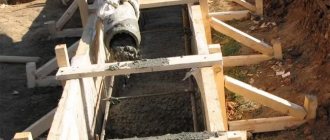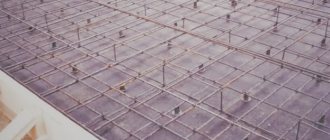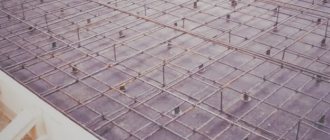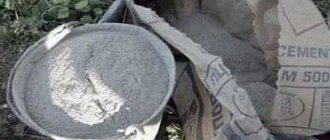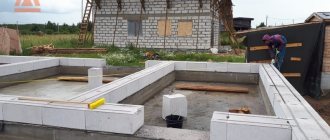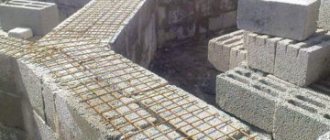Before the first stage of building a house, it is necessary to find out in particular how much concrete is needed for the foundation, because... Filling according to the technology must be done continuously, without allowing individual layers to set. This publication discusses detailed algorithms for calculating the main types of foundations.
Types of foundations
Engineers accept the foundation structurally using detailed calculation formulas. What is taken into account when choosing:
- House weight;
- Temporary loads;
- Soil type;
- Ground water level.
Having compared a number of factors and calculation results, experts accept one of the types of foundations:
- Tape;
- Pile;
- Slab;
- Columnar (only for light houses);
- Combined (complex design, which can only be accepted as a result of professional calculations).
The most common type of base is tape. This design can be adopted for a house with any parameters for all types of soils, except for floating ones. To calculate such a foundation, you need to know the height and width of its wall to the base (it is part of the foundation), as well as the perimeter of the house and the length of all internal walls.
It is advisable to choose bored piles for private housing construction - they are practically not inferior to ready-made factory products, but installing them is much easier and cheaper. The design of the pile foundation also includes a strapping grillage, which must be taken into account when calculating the concrete.
The slab is a solution for construction on floating soils. This is a kind of cushion that is able to maneuver on the base during seasonal liquefaction of the soil and during periods of its instability.
Filling materials: sand and granite
Universal auxiliary components, interacting with cement, make it possible to obtain a durable building. Regardless of the brand and type of dry product, the composition of the concrete mass includes:
- crushed stone is a durable frost-resistant stone without harmful impurities and components. To increase the hardness of the concrete mixture, granite is used, with fractions from 10 to 40 mm. Good performance properties determine the high cost and popularity of the building material.
- Sand is a sedimentary solid. A correctly selected brand of sand helps reduce the consumption of expensive limestone. For foundations, alluvial quarry sand of medium grain size from 1.2 mm to 3.5 mm is in demand. The permissible amount of impurities should not exceed 5% of the total volume of sand.
Water is added to the solution in portions until a mixture of homogeneous consistency is obtained. When mixing the constituent elements, be sure to correctly determine their proportions. The resulting voids between grains of gravel if filled incorrectly will subject the base to rapid deformation.
Concrete: buy or make it yourself?
The composition of concrete includes:
- Portland cement or slag binder;
- Sand;
- Crushed stone, better enriched;
- Plasticizers;
- Water.
You can prepare the solution yourself, but first you need to calculate the total volume - still, pouring must be done continuously and evenly. One of the options for replacing factory supplies is renting or purchasing a concrete mixer.
How to calculate the amount of cement for the foundation
The amount of cement depends on the type of concrete used. In private housing construction, concrete M300 or M400 is mainly used for the foundation. This strength is sufficient to ensure reliable and durable service of the structure.
Calculation of cement for the foundation can be done using the table of proportions:
| Concrete grade | Proportions of components C: P: Shch | Volumetric composition of cement per 10 liters of cement, l | How much concrete will be produced from 10 liters of cement, liters |
| For cement M400 | |||
| 200 | 1 : 2,8 : 4,8 | 25 : 42 | 54 |
| 250 | 1 : 2,1 : 3,9 | 19 : 34 | 43 |
| 300 | 1 : 1,9 : 3,7 | 17 : 32 | 41 |
| 400 | 1 : 1,2 : 2,7 | 11 : 24 | 31 |
| For cement M500 | |||
| 200 | 1 : 3,5 : 5,6 | 32 : 49 | 62 |
| 250 | 1 : 2,6 : 4,5 | 24 : 39 | 50 |
| 300 | 1 : 2,4 : 4,3 | 22 : 37 | 47 |
| 400 | 1 : 1,6 : 3,2 | 14 : 28 | 36 |
How much cement is needed for the foundation will be known after determining the entire volume of the supporting structure. It is worth remembering that there are 1000 liters in 1 cubic meter. Accordingly, if the calculation of the amount of M300 concrete showed 7 m3, and we had M400 cement at our disposal, we make a translation:
Proportionality line – 1: 1.9: 3.7 (C:P:SH). The figures are given in units of your choice (kilogram, liter). The bulk density of cement is 1100 kg/m3, the density of concrete is 1800-2100 kg/m3.
From 10 liters of cement we get 41 liters of concrete, approximately 24 such units are needed (1000/41). Accordingly, we multiply all proportion values by 24. (2: 45.6: 88.8).
A simpler, but average calculation of the amount of cement per foundation is given in the table:
| Concrete grade | Cement brand | Mass of cement in kg | Number of 50 kg bags of cement |
| M300 | M400 | 350 | 7 |
| M500 | 300 | 6 | |
| M400 | M400 | 400 | 8 |
| M500 | 330 | 6.6 (7 whole) |
Accordingly, you can not only calculate the cement consumption, but also determine the amount of other components by multiplying the value of the mass of cement by a proportional number. The amount of cement for the foundation according to the table is calculated approximately - the final value will be influenced by:
- Mass and fraction of sand and crushed stone;
- Exact mass of cement;
- Volume of water used.
How to calculate an average cube of concrete:
| Concrete grade | Cement | Sand | Crushed stone | Water |
| M300 | 425 | 735 | 1080 | 140 |
| M400 | 483 | 695 | 1080 | 140 |
The cement consumption for the foundation and the amount of other components should be determined using the exact formulas from the very first method, where the proportions of the components are calculated. You should also take into account the margin for error and unforeseen situations - about 10-15%. It is better if the material remains than there is not enough of it to create the main structure of the house. In addition, concrete and its components will be useful in subsequent processes of constructing walls, paths, etc.
Now you can proceed to calculating the volume of concrete for the foundation. Let us consider the main types of structures separately for ease of understanding.
Requirement for materials for the solution
The foundation can be not only concrete or reinforced concrete; there is also the option of a rubble concrete base. In this case, rubble stone is poured into the prepared trench and filled with cement-sand mortar.
It is undesirable to use concrete, since due to the crushed stone and gravel component it may not envelop the stones tightly enough and leave voids. This will certainly negatively affect the strength of the entire structure. Over time it may collapse.
The consumption of sand and binder for preparing a solution of a certain brand is usually carried out in relation to one component to another in parts. You can calculate the quantity using the ratios from the table:
It is not difficult. Let's assume that to fill a rubble foundation you need two cubes of grade 100 mortar. It has been decided to buy grade 400 cement. To prepare a heavy M100 mortar, you need 300 kg of M400 binder per cube of the mixture (reference data). How much sand will you need?
According to the table, the ratio is 1:3, which means 900 kg of sand is needed. Two cubes - twice as much. Sand is thoroughly mixed with cement and only then filled with water. Water must be added until then, constantly stirring the solution, so that it becomes plastic and freely pours into the foundation, enveloping the rubble stones. If the use of any additives is envisaged, they are first dissolved in water, and only then added to the dry composition.
We recommend watching a video showing how to properly mix the solution at home.
Strip foundation
The tape is a closed perimeter, which is located under all load-bearing and self-supporting walls of the house. In order to calculate the volume of concrete for the foundation, you need to know the following design parameters:
- Wall height. It includes underground and above-ground basement parts. The height can be classic (below the soil freezing level) or reduced.
- The width of the walls should be 100 mm greater than the thickness of the walls;
- Total length of foundation walls.
It must be taken into account that internal and external walls have different thicknesses.
Let's figure out how to calculate the foundation of a house with dimensions of 6 by 8 meters. The width of the outer walls is 500 mm, the inner walls are 400 mm, the height from the base to the wall is 1.1 meters.
Let's calculate the volume for the external walls:
- Total length: 8 + 8 + 6 + 6 = 28 meters.
- Concrete consumption is equal to the volume of the structure: 28 ∙ 1.1 ∙ 0.5 = 15.4 cubic meters.
- Volume of the inner wall: 6 ∙ 1.1 ∙ 0.38 = 2.508 m3.
- We calculate the total volume as the sum: 15.4 + 2.508 = 17.908 m3.
- Remember about the reserve of 10-15%: 17.908 + 10% = 19.69 m3 or exactly 20 cubic meters of concrete.
You can calculate the amount of cement for concrete to fill our foundation using the above algorithms.
To determine the amount of working solution, there are computer programs - calculators. They automatically determine the volume of the strip structure based on the entered parameters of width, height and wall thickness. However, most of them work without taking into account the heterogeneity of the walls; calculating the length of the walls is left to the specialist. Professional programs that are inaccessible to ordinary people show good results. They take into account the exact thickness of the walls down to the millimeter and all overlapping lengths.
How to make it easier to calculate foundation costs
Modern technologies do not bypass the construction sector, thanks to which developers have at their disposal not only an effective tool, but also all kinds of software developments for design. Using the latter, you can make both a project and calculate the required amount of materials.
The online calculator for calculating cement and fillers for making any type of foundation has proven to be a proven assistant in the preparation process. The procedure is quite simple and accessible to any novice builder; it is enough to enter certain indicators in certain columns:
- brand of Portland cement;
- base parameters;
- number of reinforcing belts;
- required grade of concrete.
The results are announced almost instantly and are displayed in the form of cubic meters of material, linear meters of reinforcement, as well as the required amount of timber for formwork. It is important to take into account that as the grade of concrete increases, the volumes of components used also increase.
Pile foundation
The second most popular type of foundation is bored pile foundation. The essence of the installation technology is to create a circular shaft, fill it with a steel frame and working concrete mortar M300-M400.
The foundation design includes piles and a grillage, which is used to tie around the made pillars, and the walls of the house rest on it. The dimensions of the grillage and piles are taken structurally.
Let's look at how to calculate the volume of concrete for pouring piles for a 6x6 house along with a grillage. Pile diameter – 200 mm, length – 2 meters, grillage width – 400 mm, height – 300 mm.
First, let's calculate the volume of the piles. Let's assume their total number is 12 (accepted constructively). All pillars will be the same, so let’s determine the volume of one. Correctly calculate it using one of the formulas:
- V = π ∙ R2 ∙ h or ¼ π ∙ D2 ∙ h.
We calculate in cubic meters for both options:
- V = 3.14 ∙ 0.12 ∙ 2.0 = 0.06 m3 or
- V = ¼ ∙ 3.14 ∙ 0.22 ∙ 2.0 = 0.06 m3.
As you can see, the result of calculation by both formulas gives one result. The amount of concrete on the foundation for pouring piles: 0.0638 ∙ 12 = 0.75 m3. As you can see, it turned out quite a bit.
Now let’s determine the volume of the grillage for a 6x6 meter house:
- Length – 6 + 6 + 6 + 6 = 24 meters.
- Volume = 24 ∙ 0.4 ∙ 0.3 = 2.88 cubic meters.
- Total amount of concrete to be poured: 2.88 + 0.75 = 3.63 m3.
- Let's add a reserve of 10%, we get 3.99 and 4.0 m3.
A similar calculation is made for columnar bases.
The adopted foundation made of bored piles is strong, durable and economical - the cost of its installation is up to 8 times less than with tape! This is not counting the lack of expensive earthworks. However, the design has several disadvantages: the impossibility of arranging a basement and the need for more thorough compaction of the floor of the first floor.
Formula and accounting of coefficients
The strip type of foundation is used both by owners in the construction of private housing and by large companies. It itself is a rectangular structure consisting of a reinforcement frame and concrete.
You can carry out calculations either using programs on the corresponding websites on the network, or independently.
Formula to clarify the volume expended: V (volume) = h (height) * b (width) * l (length of the foundation strip)
The formula can only be used with these parameters only when pouring concrete into ideally rigid formwork and for concrete preparation. Because The cubic capacity is influenced by many factors (compaction coefficient, formwork leaks, concrete residue in concrete pump pipes, etc.).
To understand the issue, it is worth considering an example:
- at the future foundation, the length of 1 wall is 30 meters (24 m is the length of the base under the outer walls, 6 m is the length of the lintel under the 1st of the internal walls);
- width is 0.4 meters;
- height is 1.5 meters.
The calculation will look like this: 30*0.4*1.5 = 18 cubic meters of concrete mixture. If it is necessary to add a correction factor of 1.1, this is done like this: 18 * 1.1 = 19.8 cubic meters the volume of concrete required.
We must not forget about the technical holes that are required for communications . Even if it seems that their size is insignificant, they take up a lot of space. It is usually recommended to subtract the volume under them from the volume obtained by the formula.
Calculating the volume does not seem too complicated, but you need to remember that the design of the base may turn out to be more complicated and individual elements will have to be calculated additionally. The final result is influenced by the characteristics of the compositions and additives that are used to strengthen the base.
Experts believe that during preliminary calculations it is permissible to increase the obtained value by ten to twenty percent.
Plate
A slab foundation is a simple structure. The difficulty lies only in choosing its optimal thickness and calculating the reinforcement frame. From the point of view of determining how many cubes of concrete are needed for the foundation, the design is calculated quite simply. Let’s take, for example, a house of 11x11 meters, the foundation for which is taken with dimensions of exactly 12 by 12 meters. The thickness of the structure is 300 mm.
The volume of the slab is 12 ∙ 12 ∙ 0.3 = 43 cubic meters.
It is not often that the slab shape is square, then the area is divided into square segments and calculated separately.
An obvious disadvantage of a slab foundation is the high consumption of concrete and cement, respectively.
Source materials
River sand is best suited for preparing the solution.
The process of preparing the initial mass consists of mixing dry substances and mixing them with water. For this you need:
- cement is a binder in powder form obtained from a mixture of clay and lime (cement clinker) with the addition of various impurities; the grade of cement depends on their ratio and the different fineness of clinker grinding;
- crushed stone of the middle fraction is a coarse aggregate, to which the standards impose requirements for purity, strength and the presence of impurities;
- sand – fine aggregate, which must be clean with a certain particle size (dune sand is not used for preparing concrete); the main enemy of sand for concrete is the presence of clay inclusions;
- water.
In some cases, gravel can be used instead of crushed stone, but due to its smooth surface it has poor adhesion to other materials, and this affects the strength of the final product.
Summary
We looked at how to calculate how much concrete is needed for a foundation. Note that the article provides the basic principles for determining the volume of structures without taking into account their features. But knowing them, you can easily calculate the required amount of consumables yourself.
How much cement is needed for a foundation is the most pressing question, because the quality and durability of structures depends on the decision. We do not recommend relying on summarized tables with average values - they do not take into account all the subtleties of calculation, selection of components and their characteristics. The tables are for informational purposes only and are not references. It is worth relying on the proportions of the components - they are compiled according to SNiPs.
By following the given algorithms, you can find out how much concrete/cement is needed to pour the foundation of a particular structure, if it is not possible to do this using a professional calculator.
Brands of cement mortars for the foundations of low-rise buildings
The brand of mortar for pouring the foundation is indicated in the specification or in the margins of the working drawings of the house or outbuilding project. Using this information and the capabilities of the Internet, you can quickly and completely free determine the proportion of cement and sand for the foundation in kilograms or liters for a particular brand of mortar. All that remains is to calculate the required volume of cement, sand and other components depending on the volume of pouring, purchase them, mix and pour the foundation.
Unfortunately, very often developers build country houses and private houses without a design. Accordingly, the question immediately arises: What are the proportions of cement for the foundation so that the structure can stand for a long time and withstand harmful factors? In this case, you should adhere to the following recommendations, based on the practical experience of many generations of private builders:
- Heavy concrete M150. Suitable for constructing a foundation for small-sized one-story buildings with walls made of cinder block, shell rock or aerated concrete. The specified grade of concrete can be used for pouring the foundation for garages and outbuildings.
- Heavy concrete M200. A universal brand of concrete suitable for the construction of foundations for 90% of low-rise buildings (one- or two-story buildings with light floors).
- Heavy concrete M300. This is a very durable concrete material with high load-bearing capacity. Used for the construction of foundations for large private houses up to 5 floors high.
Having decided on the brand of concrete, you can move on to considering a practical question: What proportions of cement and sand for the foundation should be used to prepare the selected brand of concrete?
Concrete mix composition
To produce high-quality concrete, you must use only proven materials
No construction is complete without concrete. Today it is one of the main building materials for the construction of prefabricated, monolithic concrete and reinforced concrete structures. Large construction sites receive concrete mix centrally from manufacturing plants.
At the same time, in private housing construction, it is unlikely that anyone will order a ready-made mixture - it is both expensive and pointless. A small quantity will not be accepted for ordering, and there is nowhere to use a large quantity. It is much cheaper and more reliable to purchase the necessary materials and prepare the concrete mixture in batches at the construction site.
The finished product is a hardened concrete mass, the preparation of which requires: a binder, crushed stone, sand and water. The main characteristic of concrete is its compressive strength. Its marking depends on this: M200, M300, M400, M500. For the construction of the foundation, the following types are used: M200, M300. For convenience, the calculation of material consumption is made not for the entire quantity, but for 1 cubic meter of concrete.
Materials calculation: without reinventing the wheel
How to calculate cement for the foundation? For the accuracy of the results, it is necessary to take into account the grades of concrete and cement, as well as the ratio of water and cement, which is called briefly - VC. The table below is visual and does not require a person to have a degree in mathematics.
The table is easy to use. For example, we need to prepare 2 m3 of M250 concrete:
- It requires M500 cement, which means we multiply 297 kg by 2 and get 594 kg. Now this number must be divided by 50, since this is the weight of one bag of cement: 594/50 = 11.88. We round the result towards a larger value - we get 12 bags of M500 cement.
- Crushed stone with a grain size of 20 mm for our concrete will be calculated as follows: 1188 multiplied by 2, we get 2376 kg. If you choose a different faction, then all calculations will have to be done again.
- Sand is calculated in the same way as crushed stone: 1188 * 2 = 2376 kg.
- We find water like this: multiply 205 liters by 2, resulting in 410 liters.
Indeed, calculations should not cause difficulties; you just need to decide on the required characteristics of your raw materials. If plasticizers are used for the foundation, then adjustments must be made to the calculations; the coefficients can easily be found in reference books.
Examples of calculations on various types of foundations
Tape
Accuracy in calculating how many cubes of concrete to pour will save you from unwanted expenses. Builders use 2 calculation methods:
Sometimes it is more convenient to use an online calculation service.
- Independent. How much concrete is needed to pour the foundation is calculated manually using a school math formula. You need to know the width (b), length (l) and height (h). The formula for the base volume per 1 cube is as follows: V=h*b*l + 0.02*(h*b*l).
- On an online calculator. Relevant for counting large volumes.
It is not recommended to use the strip foundation type on peat, swampy and silted soils. Such soils have low bearing capacity. In this case, it is better to take a depth of 150 cm with a part height above the ground of up to 40 cm.
Columnar type
To calculate the amount of mixture, you need to know the total number of pillars, the length and cross-sectional area of each. The grillage is considered the same as for a strip grillage. The correct calculation consists of several formulas:
Volume must be calculated for both square and circular columns.
- Volume of pillars with sections in the form of a square or rectangle: V=a*b*l*n, where a and b are sides, l is length, n is the number of pillars.
- Volumes for round ones: V=S*L*n, where area S is calculated as 3.14*R*R (radius).
- To calculate the cubic capacity of concrete, you need to add up the required quantities for the pillars and grillage, taking into account an error factor of 2%.
To find out the volumes of working solutions, use special tables that suggest consumption by type of column cross-section. An example for a circular cross-section (more often used) is presented in the table:
| Diameter, cm | Concrete consumption, cubic meter |
| 15 | 0,0354 |
| 20 | 0,0629 |
| 30 | 0,1414 |
Tiled
To calculate the monolith, a simple formula is used: L * W * H, but 20 cm are added to the width and length for accuracy. When the slab has a complex shape with stiffening ribs, the calculation should be done at the beginning of each element, and then sum them up:
The volume of the tiled base can be easily calculated by multiplying the three main parameters.
- Total volume of the slab: V=h*b*l.
- Area in shape, for example, of a trapezoid: S=h1*(a+c)/2, where a and c are the lengths of the bases, h1 is the height of the edge.
- Volume of the stiffener: V1=S*l*n, where n is the number of ribs.
- Total volume for concrete: Vtotal=V+V1.
Base from a handy container
A foundation of barrels filled with concrete is often used. The base is suitable for the construction of a summer kitchen, a small extension or a small country house. First, the required amount of the top layer of the barrel is removed. Next, make markings on the ground and dig a pit for each container. Concrete is then poured into each barrel. Most often, barrels with a height of 850 mm, a diameter of 600 mm, a capacity of 200 liters and a wall thickness of 1 mm are used. The calculation for mixing is made according to the type of columnar base of circular cross-section, taking into account the size of each barrel and grillage, if the manufacture involves its use. Due to the large volume of a standard container, a lot of concrete will be required for mixing, so a mixture without sand is not recommended, since cement consumption will increase significantly.
Formula for calculating the cubic area of the foundation.
How to calculate a cube of concrete for a foundation.
To calculate the cubic area of the primary element, use the volume calculation formula. For which I use the following data:
These data are multiplied together to obtain the cubic area of the base. Example WxHxD = cubic area. It is also worth remembering that concrete tends to shrink when it dries, this occurs due to the evaporation of water from it, so when calculating the cubic area it is worth taking this factor into account. The percentage by which concrete shrinks depends on the brand of concrete and you can find out this data from its specification.
Features of guiding the solution
When building small private houses, the concrete mixture is often prepared independently. The procedure involves the gradual introduction of water into the dry composition, followed by thorough and constant mixing of the solution to prevent hardening. For this purpose, it is recommended to use a concrete mixer. Filling work should be carried out in a short time, until the induced solution has lost the required viscosity.
Component quality requirements:
- Cement fractions from 5 to 20 mm are separated by sifting through a sieve. Dry, loose cement is suitable.
- Sand should not contain unnecessary impurities. After sifting, sand with fractions from 1.5 to 5 mm is isolated.
- Gravel or crushed stone is medium in size, ranging from 8-35 mm.
- Water should not contain an increased amount of unnecessary chemical elements or be heavily polluted.
In a humid environment, cement quickly becomes damp and lumps form. Considering this, purchase it immediately before use. If you have no experience, you should choose medium or large crushed stone. Large stones provide a denser concrete structure and prevent the formation of air bubbles.
Guiding the solution
High-quality pouring of the foundation requires removal of air bubbles or cavities from the concrete mass, which always appear during the pouring process. For this purpose, the concrete mass is compacted using specialized vibration installations for construction.
